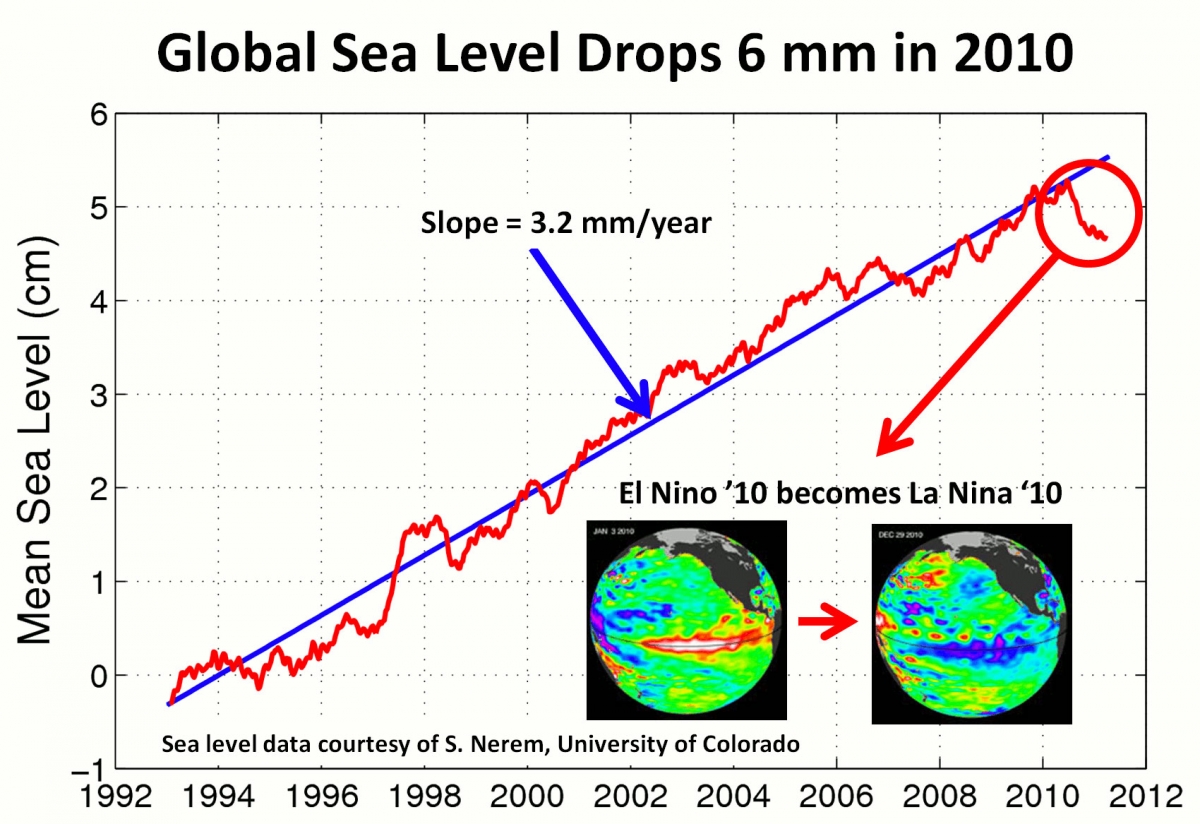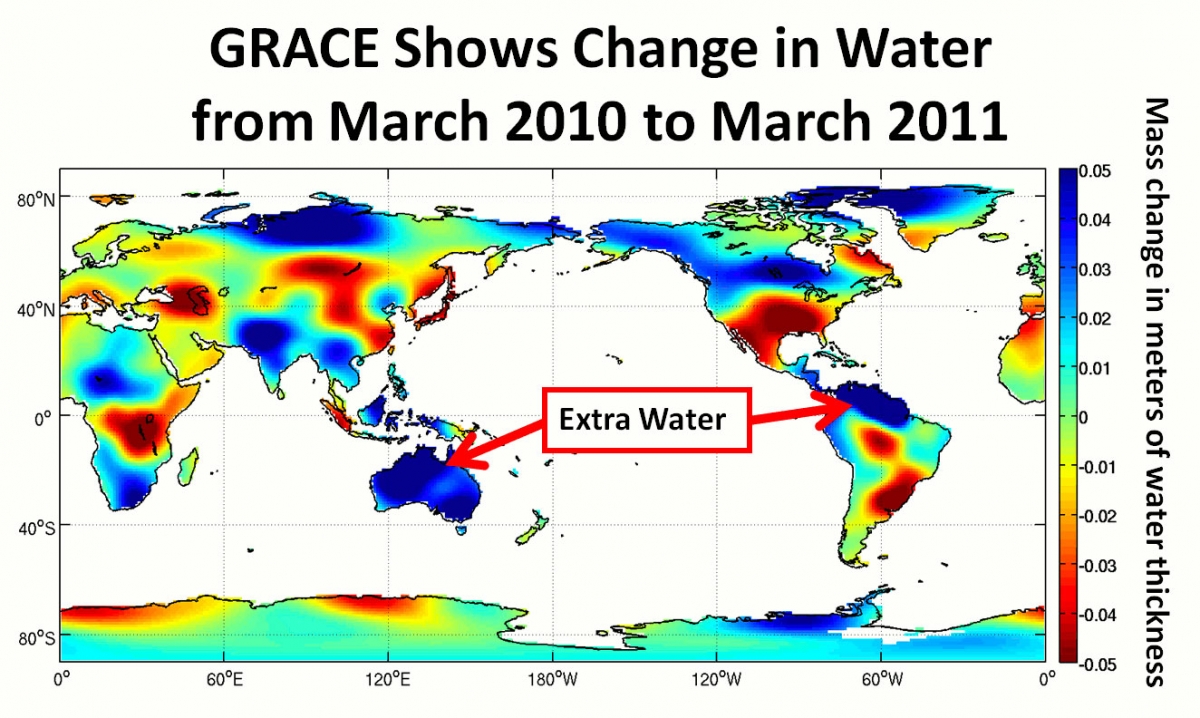Sea Level down in 2010 – Surprising effect of warming ocean
 Rising Sea level is one of the main concerns about a warming planet. You would think it would be simple: the ice melts; the sea rises. Like most things in our complex world, it’s not that simple. Surprisingly sea level went down in 2010, by a considerable amount. This new finding by the Jet Propulsion Lab (JPL) in Pasadena California, sheds light on a counterintuitive reversal factor.
Rising Sea level is one of the main concerns about a warming planet. You would think it would be simple: the ice melts; the sea rises. Like most things in our complex world, it’s not that simple. Surprisingly sea level went down in 2010, by a considerable amount. This new finding by the Jet Propulsion Lab (JPL) in Pasadena California, sheds light on a counterintuitive reversal factor.
To understand what happened, let’s have a brief review of sea level’s big “bullet points.”
- Sea Level changes significantly over hundreds of thousands of years, most noticeably with the ice ages. At the peak of an ice age, the ocean is almost 400 feet (120 m) lower than at present. The last occurrence was about 20,000 years ago. As the ice sheets melt, the ocean rises.
- For almost the last 6,000 years sea level has been relatively constant, coinciding with the period of recorded human history — and no doubt responsible for the general disbelief that sea level will ever change much.
- Sea Level changes due to three primary factors:
- Thermal expansion – as water warms it expands very slightly but noticeably.
- The amount of ice frozen on land in ice sheets and glaciers.
- Changes to water on land, e.g. lakes, dams, in the soils.
So, which of the three account for the lower sea level in 2010? Let’s look at each one.
 NASA confirmed that 2010 was tied for the warmest year on record as evidenced by the temperature chart on the left; also the decade was the warmest one on record. Ocean temperature readings confirm warming and therefore a tiny expansion factor in the volume, or height of the ocean. That does not explain the drop.
NASA confirmed that 2010 was tied for the warmest year on record as evidenced by the temperature chart on the left; also the decade was the warmest one on record. Ocean temperature readings confirm warming and therefore a tiny expansion factor in the volume, or height of the ocean. That does not explain the drop.
The ice sheets of Greenland and Antarctica are melting at record levels. The same with the vast majority of the world’s glaciers. Thus they are adding to sea level height, not reducing it.
That leaves the third issue. How much water resides on the continents. Usually this does not change significantly. But strange things are happening with precipitation patterns. Some places have droughts. Other places get record amounts of precipitation in the form of monsoon-like rains, or snow, depending on the temperature. (For the explanation of why we would get more snow in a year of warmer temperatures, see my earlier blog on the subject.)
As the oceans warm, more moisture goes up in the atmosphere. That comes down as more precipitation, although the patterns of where and when are very abnormal, again due to unusual temperature patterns.
Recent studies by JPL have now documented that enough extra precipitation fell in certain places in 2010 to account for the slight, but noticeable drop in sea level height. The majority of the increase went to the Amazon River Basin in Brasil and to Australia. This extra rain, that temporarily resides in soils, lakes, and vegetation caused the sea level to drop. That extra moisture will find its way to the sea, sooner or later.

The drop in sea level was about a quarter of an inch, or half a centimeter. While we would not notice that amount, it is significant as it temporarily reverses about two years of the rising sea level that had been measured by satellites year after year, for several decades.
This reversal of the long term trend in sea level rise (SLR) is just that. There is only so much water the ground can absorb. Flooding is the result — as we have seen in many parts of the world.The sea level decrease of 2010 will be just another “blip” on the long term trend on the graph at the very top. That obvious truth has not stopped such chronic climate deniers from using this science item to question the entire trend of warming oceans and rising sea level over the last century.
Overall warming temperatures ensures that over time, less moisture will likely reside in the soils, on average. Thus, the short term decline in sea level will soon reverse, and sea level will again move up as the 3 forces continue to be long term factors: thermal expansion; melting ice sheets and glaciers; and no net increase in the amount of water held on land in natural or artificial lakes, and in soils.
As I have written before, the long term trend of sea level — over the next few centuries — has to be a dramatic increase. It has happened before, most recently 125,000 years ago, and more profoundly a few million years ago. It is a question of how fast. We cannot predict that precisely, due to the fact that our rate of warming is thousands of times faster than during natural abrupt climate change. These are all subjects explained in my book “High Tide On Main Streeet” that should be out later this year. If you would like to be advised, please send an e-mail to book@johnenglander.net to receive an automatic notification.
